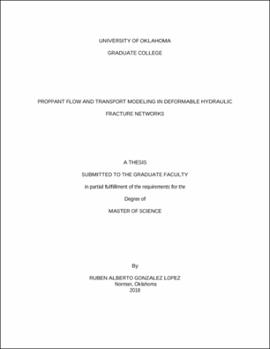| dc.description.abstract | The objective of the hydraulic fracturing stimulation is to create a large volume of fractured rock with enhanced permeability. The effectiveness of a hydraulic fracturing stimulation depends on maintaining the created fractures permeable so that proppant are used. The proppant placement process and the properties of the proppant bed strongly affects the productivity of the wells; hence, proppant transport and deposition is an essential component of the hydraulic fracture modeling. In hydraulic fracturing of low permeability unconventional reservoir, proppant transport and deposition are even more important because of the low viscosity of the fracturing fluid (usually slick water used in these treatments). The early proppant settling in low viscosity fluid may significantly reduce the effective propped length, fracture length, and therefore reduce the expected productivity of the stimulated well. Also, proppants might not be able to go through the very small natural fracture apertures which are intersected by the main hydraulic fracture. This study presents the development and verification of proppant flow and transport model for the deformable hydraulic fracture and natural networks. A proppant transport module is developed and is implemented in a 3D hydraulic fracture model “GeoFrac-3D”. The main considerations in this study is given to numerical modeling of proppant transport and deposition. The proppant flow and transport within the fracture is modeled by assuming incompressible and Newtonian fluid and representing the slurry as a mixture of fluid and proppant particles. The flow inside the fracture (s) is simulated using the finite element method. The proppant flow and transport equation is a convection dominated problem; which shows numerical instability or oscillations when using the standard Galerkin’s approach. To overcome this numerical instability of the proppant transport governing equation, the Streamline Upwinding Petrov Galerkin (SUPG) scheme is used in this work. Thedeposition of the proppant particles is modeled using the concept of the terminal velocity of a single particle which is calculated based on empirical relationships and later applying correction factors to account for the effect of the walls of the fracture and concentration of particles. The verifications of the numerical models against known analytical solutions are presented first, followed by detailed numerical examples. The numerical simulations of proppant flow and deposition in a single and multiple fractures from a horizontal well, and in networks of hydraulic and natural fractures are carried-out. A sensitivity analysis is performed to investigate the impact of parameters such as proppant size, fluid viscosity, and the discretized fracture grid sizes. The simulation results show that proppant transport and settling velocities are impacted by fluid velocity, proppant size, fluid rheology, fracture aperture, and hydraulic and natural fracture interaction angle. In case of the multiple interacting fractures, the proppant distribution is strongly impacted by the stress shadowing effect or mechanical interactions among the fractures. | en_US |
